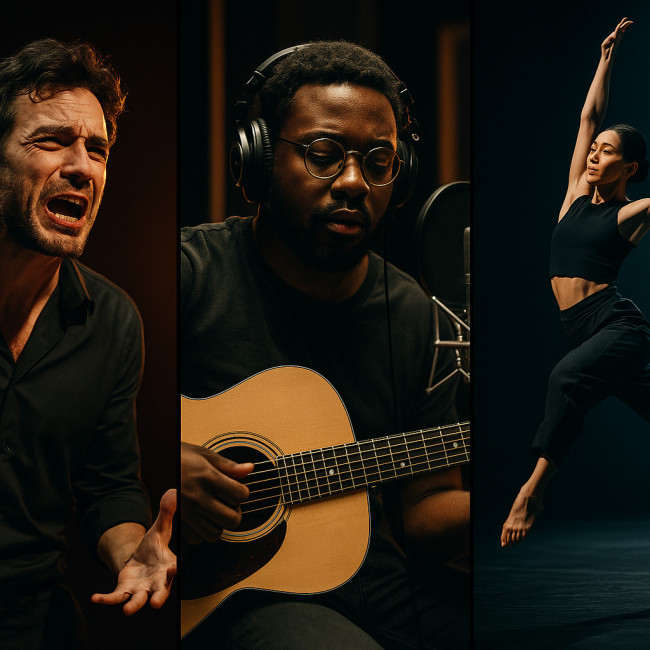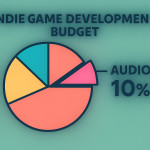Create an impactful showreel that wins auditions and remote session gigs
A well-crafted showreel is still the fastest way to prove your talent to casting teams, producers and music directors—especially when auditions move online. Follow this complete roadmap to script, shoot, edit and distribute a showreel that secures both live callbacks and paid remote session work.
Why a captivating showreel matters in 2025

Recruiters watch hundreds of clips every week. Data from leading casting platforms shows that 70 % of decisions happen in the first 45 seconds. A concise, story-driven showreel therefore multiplies your chances of landing on the shortlist, while a scattered sequence sends decision-makers scrolling to the next profile.
Source : Backstage Insights 2025
Pre-production: design a narrative that sells your uniqueness
1. Define your core hiring goal
Ask yourself which gig you want to book most—touring guitarist, ADR voice actor, or Broadway ensemble dancer. This focus shapes every clip you include and signals clarity to recruiters.
2. Curate clips that illustrate problem-solving
- Include tight close-ups for acting chemistry.
- Show multi-instrument versatility in one continuous take to prove no studio trickery.
- End with a remote-recorded segment to reassure producers you can deliver files on deadline.
3. Outline a three-act flow
- Hook (0–15 s): your strongest moment—belting high note, dramatic beat change, or comedy punchline.
- Depth (15–60 s): two to three varied scenes that highlight range and reliability.
- CTA (last 10 s): on-screen contact, union badge and portfolio URL.
Need inspiration? Study the pacing tips in these editing moves that keep recruiters watching.
Shooting day: capture quality over quantity
| Approach | Budget | Pros | Cons |
|---|---|---|---|
| Self-shot smartphone | €0-100 | Fast turnaround, authentic vibe | Risk of shaky footage, colour mismatch |
| Professional studio | €500-1 500 | Cinematic lighting, pro audio | Higher cost, scheduling lead time |
| Hybrid (DIY + pro mix) | €200-600 | Best clips outsourced, filler B-roll DIY | Requires editing finesse |
Audio matters more than pixels
Session musicians and voice actors lose 40 % of opportunities due to noisy tracks. Reference the production tweaks listed in this audio-mixing guide to hit broadcast standards.
Visual best practices
- Light your face at 45° angle; recruiters want eye contact.
- Shoot at 24 fps for drama, 30 fps for energetic music or dance.
- Use a contrasting backdrop so editors can punch-in without pixelation.
Editing: craft a seamless, searchable showreel
Keep total length under 90 seconds. Use dynamic lower thirds to display role, genre, and union affiliation. For discoverability, export captions and embed schema tags—exact tactics explained in this SEO playbook for showreels.
Polish the audio
- Normalise peaks to −1 dB.
- Apply light compression (3:1 ratio) for dialogue clarity.
- Use broadband noise reduction—no more than 6 dB to avoid artefacts.
Colour-grade for consistency
Stick to one LUT family. Sudden shifts between warm rehearsal rooms and cool outdoor shots distract rather than impress.
Add a compelling call-to-action
Overlay “Available for remote sessions – 24-bit WAV delivery within 48 h” plus a QR code that links to collaboration-ready musicians you already work with. The extra social proof reassures producers you come with a vetted network.
Distribution: put your showreel where recruiters look
1. Talent directories & casting sites
Upload native files—algorithms rank direct uploads higher than third-party embeds.
2. Personal website optimisation
Host the video with adaptive streaming so mobile viewers avoid buffering. Use structured data (<videoobject></videoobject>) to surface in search snippets.
3. Strategic outreach
- Email a 60-word pitch + thumbnail GIF to target MDs.
- Attach a one-sheet credit list hyperlinked to your remote-audition setup specs.
- Post a 15-second teaser on LinkedIn and tag recent collaborators.
Common pitfalls and quick fixes
Overstuffed montages
Solution: replace mediocre clips with high-impact moments; less content raises average quality.
Copyrighted background tracks
Use royalty-free stems or your own material; strikes can remove your reel mid-season.
Missing contact info
End screen must display email, city and time-zone for smooth session scheduling.
FAQ
- What is the ideal length for a modern showreel?
- Aim for 60-90 seconds. Recruiters rarely watch longer unless specifically requested.
- Should I create separate reels for acting and music?
- Yes. One reel per niche delivers a clear signal; you can cross-link them in your profile.
- How often should I update my showreel?
- Every 6 months or after any credit that beats your current best clip.
- Do self-tapes belong in a showreel?
- Only if shot at broadcast quality and showcasing skills unavailable in your live footage.
Quick self-assessment quiz
Action checklist
- Script a three-act structure focused on one hiring goal.
- Record in 4K, 24-bit audio or hire a studio for signature clips.
- Edit to 90 seconds, normalise peaks and colour-grade consistently.
- Upload native files to casting platforms and your website.
- Pitch with a thumbnail GIF and CTA to book a call.
Ready to book more gigs? Update your showreel today and pair it with the internal tips above—your next audition invite could be one play button away.











